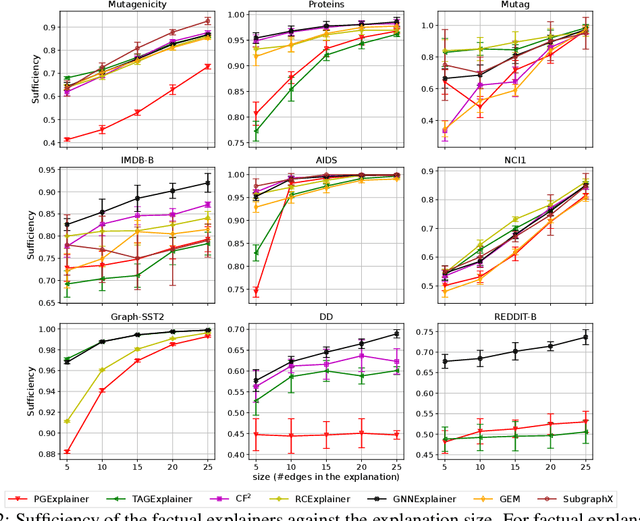Samidha Verma
GRAIL: Graph Edit Distance and Node Alignment Using LLM-Generated Code
May 04, 2025Abstract:Graph Edit Distance (GED) is a widely used metric for measuring similarity between two graphs. Computing the optimal GED is NP-hard, leading to the development of various neural and non-neural heuristics. While neural methods have achieved improved approximation quality compared to non-neural approaches, they face significant challenges: (1) They require large amounts of ground truth data, which is itself NP-hard to compute. (2) They operate as black boxes, offering limited interpretability. (3) They lack cross-domain generalization, necessitating expensive retraining for each new dataset. We address these limitations with GRAIL, introducing a paradigm shift in this domain. Instead of training a neural model to predict GED, GRAIL employs a novel combination of large language models (LLMs) and automated prompt tuning to generate a program that is used to compute GED. This shift from predicting GED to generating programs imparts various advantages, including end-to-end interpretability and an autonomous self-evolutionary learning mechanism without ground-truth supervision. Extensive experiments on seven datasets confirm that GRAIL not only surpasses state-of-the-art GED approximation methods in prediction quality but also achieves robust cross-domain generalization across diverse graph distributions.
GNNX-BENCH: Unravelling the Utility of Perturbation-based GNN Explainers through In-depth Benchmarking
Oct 03, 2023



Abstract:Numerous explainability methods have been proposed to shed light on the inner workings of GNNs. Despite the inclusion of empirical evaluations in all the proposed algorithms, the interrogative aspects of these evaluations lack diversity. As a result, various facets of explainability pertaining to GNNs, such as a comparative analysis of counterfactual reasoners, their stability to variational factors such as different GNN architectures, noise, stochasticity in non-convex loss surfaces, feasibility amidst domain constraints, and so forth, have yet to be formally investigated. Motivated by this need, we present a benchmarking study on perturbation-based explainability methods for GNNs, aiming to systematically evaluate and compare a wide range of explainability techniques. Among the key findings of our study, we identify the Pareto-optimal methods that exhibit superior efficacy and stability in the presence of noise. Nonetheless, our study reveals that all algorithms are affected by stability issues when faced with noisy data. Furthermore, we have established that the current generation of counterfactual explainers often fails to provide feasible recourses due to violations of topological constraints encoded by domain-specific considerations. Overall, this benchmarking study empowers stakeholders in the field of GNNs with a comprehensive understanding of the state-of-the-art explainability methods, potential research problems for further enhancement, and the implications of their application in real-world scenarios.
Empowering Counterfactual Reasoning over Graph Neural Networks through Inductivity
Jun 07, 2023Abstract:Graph neural networks (GNNs) have various practical applications, such as drug discovery, recommendation engines, and chip design. However, GNNs lack transparency as they cannot provide understandable explanations for their predictions. To address this issue, counterfactual reasoning is used. The main goal is to make minimal changes to the input graph of a GNN in order to alter its prediction. While several algorithms have been proposed for counterfactual explanations of GNNs, most of them have two main drawbacks. Firstly, they only consider edge deletions as perturbations. Secondly, the counterfactual explanation models are transductive, meaning they do not generalize to unseen data. In this study, we introduce an inductive algorithm called INDUCE, which overcomes these limitations. By conducting extensive experiments on several datasets, we demonstrate that incorporating edge additions leads to better counterfactual results compared to the existing methods. Moreover, the inductive modeling approach allows INDUCE to directly predict counterfactual perturbations without requiring instance-specific training. This results in significant computational speed improvements compared to baseline methods and enables scalable counterfactual analysis for GNNs.
Task and Model Agnostic Adversarial Attack on Graph Neural Networks
Dec 25, 2021



Abstract:Graph neural networks (GNNs) have witnessed significant adoption in the industry owing to impressive performance on various predictive tasks. Performance alone, however, is not enough. Any widely deployed machine learning algorithm must be robust to adversarial attacks. In this work, we investigate this aspect for GNNs, identify vulnerabilities, and link them to graph properties that may potentially lead to the development of more secure and robust GNNs. Specifically, we formulate the problem of task and model agnostic evasion attacks where adversaries modify the test graph to affect the performance of any unknown downstream task. The proposed algorithm, GRAND ($Gr$aph $A$ttack via $N$eighborhood $D$istortion) shows that distortion of node neighborhoods is effective in drastically compromising prediction performance. Although neighborhood distortion is an NP-hard problem, GRAND designs an effective heuristic through a novel combination of Graph Isomorphism Network with deep $Q$-learning. Extensive experiments on real datasets show that, on average, GRAND is up to $50\%$ more effective than state of the art techniques, while being more than $100$ times faster.
 Add to Chrome
Add to Chrome Add to Firefox
Add to Firefox Add to Edge
Add to Edge